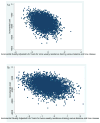Sustained economic benefits of resistance training in community-dwelling senior women
- PMID: 21718265
- PMCID: PMC4019577
- DOI: 10.1111/j.1532-5415.2011.03474.x
Sustained economic benefits of resistance training in community-dwelling senior women
Abstract
To determine whether the health and cost benefits of resistance training were sustained 12 months after formal cessation of the intervention.
Design: Cost-utility analysis conducted alongside a randomized controlled trial.
Setting: Community-dwelling women aged 65 to 75 living in Vancouver, British Columbia.
Participants: One hundred twenty-three of the 155 community-dwelling women aged 65 to 75 years who originally were randomly allocated to once-weekly resistance training (n=54), twice-weekly resistance training (n=52), or twice-weekly balance and tone exercises (control group; n=49) participated in the 12-month follow-up study. Of these, 98 took part in the economic evaluation (twice-weekly balance and tone exercises, n=28; once-weekly resistance training, n=35; twice-weekly resistance training, n=35).
Measurements: The primary outcome measure was incremental cost per quality-adjusted life year (QALY) gained. Healthcare resource utilization was assessed over 21 months (2009 prices); health status was assessed using the EuroQol-5D to calculate QALYs using a 21-month time horizon.
Results: Once- and twice-weekly resistance training were less costly than balance and tone classes, with incremental mean healthcare costs of Canadian dollars (CAD$)1,857 and CAD$1,077, respectively. The incremental QALYs for once- and twice-weekly resistance training were -0.051 and -0.081, respectively, compared with balance and tone exercises.
Conclusion: The cost benefits of participating in a 12-month resistance training intervention were sustained for the once- and twice-weekly resistance training group, whereas the health benefits were not.
Trial registration: ClinicalTrials.gov NCT00426881.
© 2011, Copyright the Authors. Journal compilation © 2011, The American Geriatrics Society.
Conflict of interest statement
[Table: see text]
Figures

References
-
- Brookmeyer R, Johnson E, Ziegler-Graham K, Arrighi H. Forecasting the global burden of Alzheimer’s disease. Alzheimer’s and Dementia. 2007;3:186–191. - PubMed
-
- Liu-Ambrose T, Donaldson MG, Ahamed Y, et al. Otago home-based strength and balance retraining improves executive functioning in older fallers: a randomized controlled trial. J Am Geriatr Soc. 2008;56:1821–1830. - PubMed
-
- Cassilhas RC, Viana VA, Grassmann V, et al. The impact of resistance exercise on the cognitive function of the elderly. Medicine and science in sports and exercise. 2007;39:1401–1407. - PubMed
Publication types
MeSH terms
Associated data
Grants and funding
LinkOut - more resources
Full Text Sources
Medical
Miscellaneous

